
INSTRUCTION MANUAL
GUIDE D'UTILISATION
MANUAL DE INSTRUCCIONES
INSTRUCTIVO DE OPERACIÓN, CENTROS DE SERVICIO Y PÓLIZA
DE GARANTÍA. ADVERTENCIA: LÉASE ESTE INSTRUCTIVO ANTES
DE USAR EL PRODUCTO.
DEWALT Industrial Tool Co., 701 Joppa Road, Baltimore, MD 21286
(AUG09) Part No. N042236 D26950, D26960 Copyright © 2009 D
EWALT
The following are trademarks for one or more D
EWALT power tools: the yellow and black
color scheme; the “D” shaped air intake grill; the array of pyramids on the handgrip; the kit box
configuration; and the array of lozenge-shaped humps on the surface of the tool.
D26950, D26960
Heavy-Duty Heat Gun
Pistolets thermiques industriels
Pistolas de aire caliente para trabajos pesados
If you have questions or comments, contact us.
Pour toute question ou tout commentaire, nous contacter.
Si tiene dudas o comentarios, contáctenos.
1-800-4-DEWALT • www.dewalt.com
Definitions: Safety Guidelines
The definitions below describe the level of severity for each signal word. Please read the
manual and pay attention to these symbols.
DANGER: Indicates an imminently hazardous situation which, if not avoided, will result
in death or serious injury.
WARNING: Indicates a potentially hazardous situation which, if not avoided, could
result in death or serious injury.
CAUTION: Indicates a potentially hazardous situation which, if not avoided, may result
in minor or moderate injury.
NOTICE: Indicates a practice not related to personal injury which, if not avoided, may
result in property damage.
IF YOU HAVE ANY QUESTIONS OR COMMENTS ABOUT THIS OR ANY DEWALT TOOL,
CALL US TOLL FREE AT: 1-800-4-D
EWALT (1-800-433-9258)
DANGER: To reduce the risk of injury, read the instruction manual. Failure to follow all
instructions listed below may result in electric shock, fi re and/or serious injury.
IMPORTANT SAFETY INSTRUCTIONS
READ THESE INSTRUCTIONS
Safety Instructions for Heat Guns
• To reduce the risk of explosion, DO NOT use in paint spray booths or within 10' (3.0 m) of
paint spraying operations.
• This appliance has a polarized plug (one blade is wider than the other). To reduce the risk of
electric shock, this plug is intended to fit in a polarized outlet only one way. If the plug does
not fit fully in the outlet, reverse the plug. If it still does not fit, contact a qualified electrician.
Do not modify the plug in any way.
• DO NOT use this tool to remove paint containing lead. The peelings, residue and vapors
of paint may contain lead which is poisonous
• Hidden areas such as behind walls, ceilings, floors, soffit boards and other panels may
contain flammable materials that could be ignited by the heat gun when working in these
locations. The ignition of these materials may not be readily apparent and could result in
property damage and injury to persons. When working in these locations, keep the heat gun
moving in a back-and-forth motion. Lingering or pausing in one spot could ignite the panel or
the material behind it.
NOTE: These heat guns are capable of producing temperatures in excess of 1000˚ F
• DO NOT use this tool as a hair dryer.
• DO NOT use this tool to heat food.
• DO NOT lay the heat gun on flammable surfaces when operating the gun or immediately after
shutting it off. Allow the tool to cool before storing. Always set the gun on a flat level surface
so that the nozzle tip is pointed upward.
• DO NOT use in the presence of explosive materials.
• Keep moveable items secured and steady while scraping.
• NEVER obstruct the air intake or nozzle outlet. This may cause excessive heat build up
resulting in damage to the tool.
• Be sure to direct the hot air blast in a safe direction; away from other people or flammable
objects.
• DO NOT remove the heat barrel cover during use.
• KEEP FINGERS AWAY FROM METAL NOZZLE; it becomes very hot during use and
remains hot for 30 minutes after use. Wear gloves to protect hands.
• ALWAYS keep nozzle away from cord.
• DO NOT touch the nozzle to any surface while running or shortly after running.
• DO NOT place anything inside the nozzle as it could cause an electric shock. Do not look
down the nozzle while the unit is turned on due to the high temperatures being produced.
• Splinters and small particles of stripped paint can be ignited and blown through holes and
cracks in the surface being stripped.
• DO NOT apply heat to the same area for a long period of time.
• DO NOT burn the paint. Use the scraper provided and keep the nozzle at least 1" (25 mm)
away from the painted surface. When working in a vertical direction, work downwards to
prevent paint from falling into the tool and burning.
• DO NOT allow paint to adhere to the nozzle or scraper. It could ignite.
• ALWAYS use good quality scrapers and stripping knives.
• DO NOT use the heat gun in combination with chemical strippers.
• DO NOT use accessory nozzles as scrapers.
• DO NOT direct heatgun airflow directly on glass. The glass may crack and could result in
property damage or personal injury.
• Maintain labels and nameplates. These carry important information.
• Place the heat gun on a stable, level surface when not hand held. Place the cord in a position
that won't cause the heat gun to tip over.
• Be constantly aware that this tool can ignite flammable materials, soften or melt others.
Regardless of the task you are performing, shield or keep the heat gun away from these
materials.
• You may occasionally notice some slight smoking of the tool after it is turned off. This is
the result of heating the residual oil that was deposited on the heating element during the
manufacturing process.
• Use eye protection and other safety equipment.
• Do not abuse the cord. Never use the cord for carrying, pulling or unplugging the tool.
Keep cord away from heat, oil, sharp edges or moving parts. Damaged or entangled
cords increase the risk of electric shock.
• When operating a tool outdoors, use an extension cord suitable for outdoor use. Use
of a cord suitable for outdoor use reduces the risk of electric shock.
• Do not expose tools to rain or wet conditions. Water entering a tool will increase the risk
of electric shock.
• Do not overreach. Keep proper footing and balance at all times. This enables better
control of the tool in unexpected situations.
• Store idle tools out of the reach of children and do not allow persons unfamiliar with
the tool or these instructions to operate the tool. Tools are dangerous in the hands of
untrained users.
• Have your tool serviced by a qualified repair person using only identical replacement
parts. This will ensure that the safety of the tool is maintained.
• Air vents often cover moving parts and should be avoided. Loose clothes, jewelry or long
hair can be caught in moving parts.
• An extension cord must have adequate wire size (AWG or American Wire Gauge) for
safety. The smaller the gauge number of the wire, the greater the capacity of the cable, that
is 16 gauge has more capacity than 18 gauge. An undersized cord will cause a drop in line
voltage resulting in loss of power and overheating. When using more than one extension to
make up the total length, be sure each individual extension contains at least the minimum
wire size. The following table shows the correct size to use depending on cord length and
nameplate ampere rating. If in doubt, use the next heavier gauge. The smaller the gauge
number, the heavier the cord.
Minimum Gauge for Cord Sets
Ampere Rating
Volts Total Length of Cord in Feet (meters)
120V
25 (7.6) 50 (15.2) 100 (30.5) 150 (45.7)
240V
50 (15.2) 100 (30.5) 200 (61.0) 300 (91.4)
More
Than
Not More
Than
AWG
0 6 18 16 16 14
610 18161412
10 12 16 16 14 12
12 16 14 12 Not Recommended
WARNING: Always use eye protection. All users and bystanders must wear eye protection
that conforms to ANSI Z87.1.
WARNING: Always wear proper personal hearing protection that conforms to ANSI
S12.6 (S3.19) during use. Under some conditions and duration of use, noise from this product
may contribute to hearing loss.
WARNING: Some dust created by power sanding, sawing, grinding, drilling, and other
construction activities contains chemicals known to cause cancer, birth defects or other
reproductive harm. Some examples of these chemicals are:
• lead from lead-based paints,
• crystalline silica from bricks and cement and other masonry products, and
• arsenic and chromium from chemically-treated lumber (CCA).
Your risk from these exposures varies, depending on how often you do this type of work. To
reduce your exposure to these chemicals: work in a well ventilated area, and work with approved
safety equipment, such as those dust masks that are specially designed to filter out microscopic
particles.
WARNING: ALWAYS USE SAFETY GLASSES. Everyday eyeglasses are NOT safety glasses.
Also use face or dust mask if cutting operation is dusty. All users and bystanders MUST ALWAYS
wear certified safety equipment:
• ANSI Z87.1 eye protection (CAN/CSA Z94.3),
• ANSI S12.6 (S3.19) hearing protection,
• NIOSH/OSHA/MSHA respiratory protection.
• The label on your tool may include the following symbols. The symbols and their definitions
are as follows:
V .....................volts A .................. amperes
Hz ...................hertz W ................. watts
min ..................mi nutes
............... alternating current
................direct current
n
o ................ no load speed
....................Class I Construction ................. earthing terminal
........................(grounded) ................ safety alert symbol
.....................Class II Construction BPM ............ beats per minute
........................(double insulated) …/min ......... revolutions or
sfpm ..............surface feet
.................... reciprocation
......................per minute (sfpm) ...................per minute
PERSONS REMOVING PAINT SHOULD ALWAYS FOLLOW THESE GUIDELINES:
WARNING: Extreme care should be taken when stripping paint. The peelings, residue and
vapors of paint may contain lead, which is poisonous. Any pre-1977 paint may contain lead and
paint applied to homes prior to 1950 is likely to contain lead. Once deposited on surfaces, hand
to mouth contact can result in the ingestion of lead. Exposure to even low levels of lead can
cause irreversible brain and nervous system damage; young and unborn children are particularly
vulnerable.
Before beginning any paint removal process you should determine whether the paint you are
removing contains lead. This can be done by your local health department or by a professional
who uses a paint analyzer to check the lead content of the paint to be removed. LEAD-BASED
PAINT SHOULD ONLY BE REMOVED BY A PROFESSIONAL AND SHOULD NOT BE
REMOVED USING A HEAT GUN. Persons removing paint should follow these guidelines:
1. Move the workpiece outdoors. If this is not possible, keep the work area well ventilated. Open
the windows and put an exhaust fan in one of them. Be sure the fan is moving the air from
inside to outside.
2. Remove or cover any carpets, rugs, furniture, clothing, cooking utensils and air ducts.
3. Place drop cloths in the work area to catch any paint chips or peelings. Wear protective
clothing such as extra work shirts, overalls and hats.
4. Work in one room at a time. Furnishings should be removed or placed in the center of the
room and covered. Work areas should be sealed off from the rest of the dwelling by sealing
doorways with drop cloths.
5. Children, pregnant or potentially pregnant women and nursing mothers should not be
present in the work area until the work is done and all clean up is complete.
6. Wear a dust respirator mask or a dual filter (dust and fume) respirator mask which has
been approved by the Occupational Safety and Health Administration (OSHA), the National
Institute of Safety and Health (NIOSH), or the United States Bureau of Mines. These masks
and replaceable filters are readily available at major hardware stores. Be sure the mask
fits. Beards and facial hair may keep masks from sealing properly. Change filters often.
DISPOSABLE PAPER MASKS ARE NOT ADEQUATE.

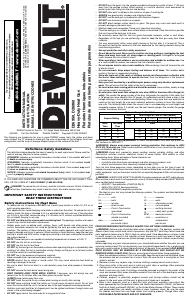


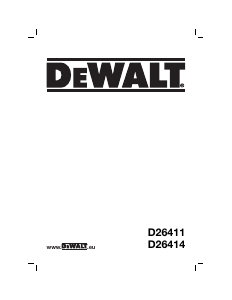

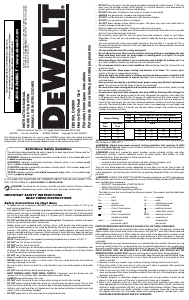
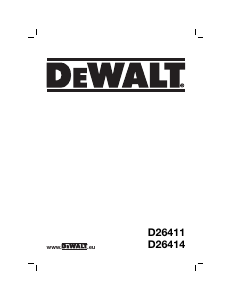
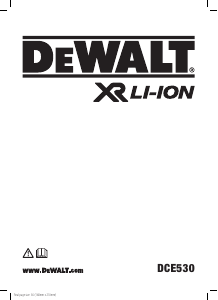
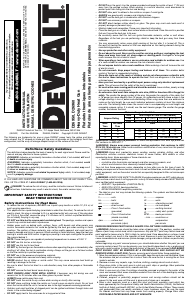
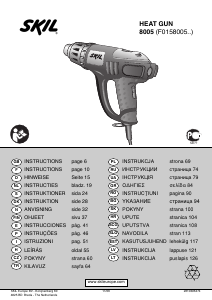
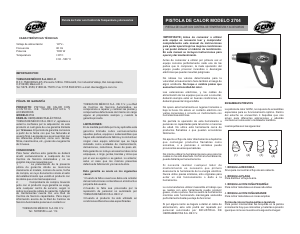
Únase a la conversación sobre este producto
Aquí puedes compartir lo que piensas sobre DeWalt D26960 Decapador por aire caliente. Si tiene alguna pregunta, primero lea atentamente el manual. Puede solicitar un manual utilizando nuestro formulario de contacto.